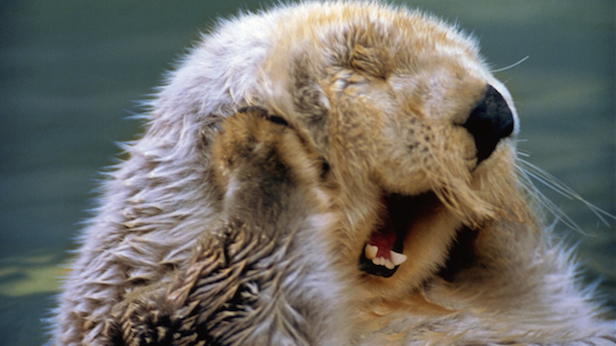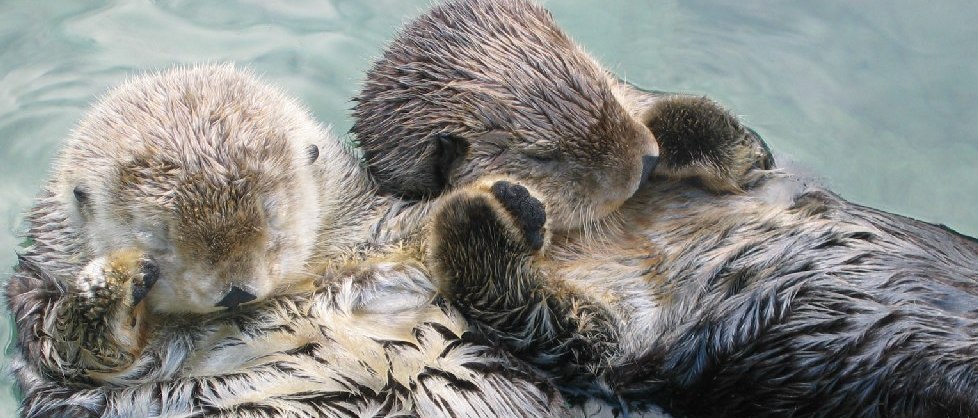
Scientific Name: Enhydra Lutris
Weight(M): 22-45kg
(F): 14-35kg
(New Born): 1.4-2.3kg
Predator: Great White Shark
Lifespan(M):10-15 years
(F): 15-20 years
IUCN Red List: Endangered
Trophic Level: Omnivore
Diet: Sea Urchins, Mollusks, Crustaceans and
some species of fish
Habitat: Coasts of the Northern & Eastern North
Pacific Ocean
Description: Sea Otter has no blubber, and it relies
on its thick fur to keep warm. The fur consists of
long, waterproof guard hairs and short underfur.
The guard hairs keep the dense underfur dry. The
guard hairs of the Sea Otters have the ability to
repel water. The Sea Otter has the ability to reach
and groom any part of its body. They have a loose
skin and an unusually supple skeleton. The hind
feet, which provides a propulsion in swimming, are long broadly flattened, and fully webbed. The tail is
short, thick, slightly flattened and muscular. Long,
highly sensitive whiskers and front paws help the
sea otters to find prey by their sense of touch
when waters are dark and gloomy. Their molars
are flat and round and were used for crushing and
not for cutting food. Its large kidneys enable it to
derive fresh water from the sea and excrete
concentrated urine.


- Heaviest member of Mustelidae Family.
- It is the smallest marine mammal.
- It is the one of the keystone species controlling Sea Urchin populations.
- They protect the kelp forest ecosystems.
- They use rocks to dislodge its prey and open the
shell. - One of the few mammal species to use tools.


- Their closest extant relatives the African
Speckle-Throated Otter, European Otter, African
Clawless Otter, and Oriental Small-Clawed Otter
were its ancestor 5 million years ago. - Sea Otters are diurnal which is they are active
during the day time and inactive at night. - They can hold breath for five minutes while
diving. - Sensitive vibrissae and forepaws enable sea
otters find their prey using their sense of touch. - Vibrissae: Long stiff hairs growing around the or
on the face of many mammals which is used as
the organ of touch (also known as Whiskers).

- Sea Otters spend much time grooming, which
consists of cleaning fur, untangling knots,
removing loose fur, rubbing the fur to squeeze
out water and introduce air, blowing air into fur.


- When eating, they roll in the water very often to
wash out the food scraps from their fur. - It is the only marine mammal to catch fish with
its paws rather than with its teeth. - Under each foreleg, the sea otter has a loose
pouch which extends till the chest. - In this pouch, they store the collected food to
bring it to the surface. - This pouch can also hold rock, which used to
break open shellfish and clams.

- A Group of Resting Sea Otters is known as Raft.

- A raft contains 10 to 100 animals, with male rafts
being larger than the female rafts. - To prevent drifting out to the sea, when resting
and eating, sea otters wrap themselves with
kelp.

- The cry of the pup is often compared to a gull.
- Sea Otters are polygynous.
- Where males have multiple females.
- Mating in Sea Otters can be rough.
- Males biting females in the muzzle which leaves
scars on the nose. - Females sometimes hold their head under
water.

- Birth usually takes place in the water.
- Twins birth in sea otters is very rare.
- Usually only one pup survives.

- At birth, the pup’s eyes are open, ten teeth will
be visible and the pup will have a thick coat of
fur. - Mothers lick and fluff a newborn’s hair; after
grooming the pup’s fur retains so much air. - The fluffy baby fur is replaced into adult fur after
13 weeks. - A mother gives almost constant affection,
cradling it on her chest away from the cold water
and grooming its fur. - Sea Otters live in coastal waters in 15-23metres
deep. - Alaska is the heartland of Sea Otter’s range.
- Thousands of Sea Otters were killed in 1989 in
Prince William Sound, Gulf of Alaska which was
hit by the Exxon Valdez Oil Spill.

- Sea Otters are a classic example of keystone
species. - They keep the population of benthic herbivores
such as sea urchins. - When sea urchins graze the lower parts of kelp,
they cause the kelps to drift away and die. - Loss of habitat provided by kelp forests leads to
great extinction on the marine ecosystem. - When the prey’s resources disappear, they
starve and go extinct as well.
Predators
- In the Sea, Orcas and Sea Lions are the
predators.


- Bald Eagles may grab the pups from the surface
of the water. - On Land, Sea Otters face an attack from bears
and coyotes.

- In California, the Great White Shark are their
primary predator.

Threats
- Sea Otters were also killed by Toxoplasma
gondii, obligate parasite of felids which is caused
by the urban runoff which contains cat feces that
is brought to the oceans.

- Sea Otters of Washington were infected by with
the H1N1 flu virus. - They were also infected by the Parasitic
infections of Sarcocystis neurona which is
involved by human activity. - Thousands of years ago Sea Otter skins were
hunted by Indigenous people.

- Oil Pollution, predation by Orcas, poaching and
Sea Otters drown when entangled in fishing
gears. - The most significant threat is oil spills.
- When their fur is soaked with oil, it loses its ability to retain air, and they quickly die from
Hypothermia. - The Liver, Kidneys and Lungs of the Sea Otters
also become damaged when they inhale oil or
ingest it while grooming it.


Sea Otters during Oil Spil
- A Sea Otter named Nyac was a survivor of the
Exxon Valdez Oil Spill but, he died in September
2008 at the age of 20. - Milo, died out of Lymphoma in January 2012.
- The lighter one is Nyac and the darker one is
Milo
